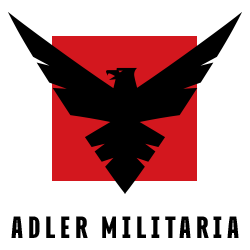Showing 235–243 of 245 resultsSorted by latest
-

WWII Red Army Soviet Propaganda – For German Soldier – Pass to POW – Bank Note – 23.04.1945 – Rare – Berlin 1945
$39.50A very late pass to surrender to the Red Army, made in the form of a bank note to capture attention. Very late war (23.04.1945) perhaps used during the battle for Berlin 1945.
-
Sale!
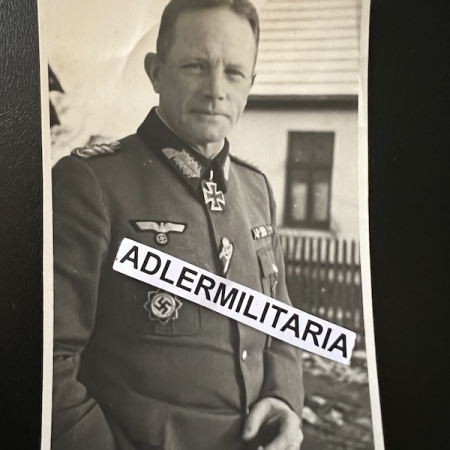
WWII German Photo – Generalleutnant Henze – Dzukste -Kurland 1944 – 21. Feld-Division (L)
$255.00Original price was: $255.00.$155.00Current price is: $155.00.Henze, Albert (Generalleutnant) Date of birth: August 7th, 1894 (Kirchhain/Hesse, Germany) Date of death: March 31st, 1979 (Ingolstadt/Bavaria, Germany) Nationality: German (1933-1945, Third Reich) Biography Promotions: January 27th, 1915: Gefreiter; April 21st, 1915: Unteroffizier; August 2nd, 1915: Vizefeldwebel; March 20th, 1916: Leutnant der Reserve; May 20th, 1920: Leutnant (Polizei); October 21st, 1934: Hauptmann (Reichsheer); January 1st, 1939: Major; December 1st, 1941: Oberstleutnant; April 1st, 1942: Oberst; November 9th, 1944: Generalmajor; May 1st, 1945: Generalleutnant. Ritterkreuz mit Eichenlaub Period: Second World War (1939-1945) Rank: Generalmajor (Brigadier) Unit: Kommandeur, Gruppe Henze, 21. Feld-Division (L), Luftwaffe Awarded on: January 21st, 1945 At the beginning of the battle of Courland, on the 23.12.1944, the Soviets managed to penetrate deeply into the combat area of the 21. Feld-Division (L) south of Dzukste following heavy artillery preparation. On the next day the Soviets continued their attack against the centre of the Division’s front with 6 rifle divisions and the bulk of a tank corps. Recognizing the danger of a breakthrough, Generalmajor Henze ordered a counterattack into the flank of the Soviet assault formation. This counterthrust managed to succeed with the support of Sturmgeschütze, and a new defensive line was formed. Soviet losses amounted to 90 tanks, 3 assault guns and 5 artillery pieces. Henze would receive the Oakleaves for this action. 709th Award.
-

WWII German Photograph – General Leo Geyr von Schweppenburg – Normandy 1944 – Wearing British Dust Glasses – Super Rare Photo
$265.00An amazing photograph, displaying him with dust glasses taken from the British Army. Geyr von Schweppenburg (2 March 1886 – 27 January 1974) was a German general during World War II who is noted for his pioneering stance and expertise in the field of armoured warfare.[2][3] He commanded the 5th Panzer Army (formalised as Panzer Group West) during the Invasion of Normandy, and later served as Inspector General of Armoured Troops. After the war, he was involved in the development of the newly-built German Army (Bundeswehr). Freiherr von Geyr was born in 1886 in Potsdam into the Prussian military aristocracy and descended from a family that had produced two Prussian field marshalls.[4] He joined the German Army in 1904. In World War I, he fought on several fronts and rose to the rank of captain. After the war, he remained in the army, becoming an Oberst in 1932 and a Generalmajor in 1935. From 1933 to 1937, he was a military attaché to the United Kingdom, Belgium and the Netherlands and resided in London. Promoted to Generalleutnant upon his return from London, he took command of the 3rd Panzer (armoured) Division in 1937.[5] World War II From 1 September to 7 October 1939, Geyr commanded the 3rd Panzer Division during the invasion of Poland, where it was the most numerically powerful Panzer Division, with 391 tanks.[6] For a victory at Kulm, he was praised on the battlefield by Hitler, who had visited the division in recognition for its achievements in Poland.[7] He was promoted to General der Kavallerie of the XXIV Panzer Corps on 15 February 1940. In 1940, he commanded the XXIV Panzer Corps in the Invasion of France. In 1941, in the invasion of the Soviet Union, Geyr’s XXIV Panzer Corps was part of General Heinz Guderian’s Second Panzer Army, and consisted of all of Guderian’s major tank units.[8] On 9 July 1941, he was awarded the Knight’s Cross of the Iron Cross as General der Panzertruppe.[9] By early November 1941, Geyr’s Panzer Corps commanded the 3rd, 4th, and 17th Panzer Divisions, the panzer regiment from the 18th Panzer Division, as well as the Infantry Regiment Großdeutschland, and spearheaded the advance of Army Group Centre during the Battle of Moscow.[8] From 21 July 1942, taking over from the court-martialed Georg Stumme,[10] to 30 September 1942, he was commanding General of the XXXX Panzer Corps, taking part in the fighting in the Caucasus. Geyr was relieved in a command cadre shakeup at the end of September 1942.[10] In the spring of 1943, Field Marshal Gerd von Rundstedt ordered Geyr to prepare a force of 10 Panzer and motorised infantry divisions. On 19 November 1943, Geyr’s command was formalised as Panzer Group West, which had responsibility for the training and formation of all armoured units in the west. The group of armoured divisions near Paris constituted the Germans’ main force of tanks in France. In the event of an Allied landing on the northern French coast, Panzer Group West was expected to counterattack northward and to halt the invasion force.[11] The Allied invasion of Normandy took place on 6 June 1944. By 8 June, Geyr had moved three panzer divisions northward against British and Canadian forces advancing on the town of Caen. On, Royal Air Force aircraft attacked his newly-established headquarters at La Caine in Normandy. Geyr was wounded and many of his staff officers were killed, which forced the cancellation of the counterattack.[12] Geyr’s reinforced tank units managed to prevent the British advance for another month, but he was nevertheless relieved of his command on 2 July after seconding Rundstedt’s request for Hitler to authorize a strategic withdrawal from Caen.[13][14][15] He was succeeded by Heinrich Eberbach on 4 July and served as Inspector General of Armoured Troops until the closing phase of the war
-
Sale!

WWII German Knights Cross Holder – Karl-Conrad Mecke – Raid on St Nazaire – 22 Marine Flak Regiment
$225.00Original price was: $225.00.$165.00Current price is: $165.00.An extremely desirable and rare postcard size photograph of Mecke with his Knights Cross, which he won during the British raid on St Nazaire, also known as the Greatest Raid of All. Knights Cross action: Awarded for his role in combating the British raid on St. Nazaire, Operation Chariot, on 28.03.1942. Due to the unusual behaviour of the British bombers it was Mecke who recognized the potential of a landing and put his troops on alert. His guns later opened fire on the British convoy despite their disguise as German vessels and also participated in the fight against the British landing forces.
-
Sale!
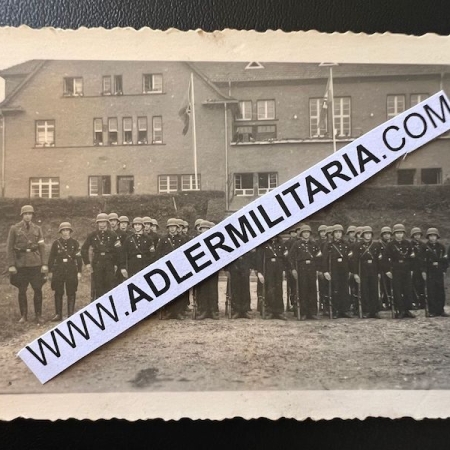
WWII German Photograph – Hitler Youth Bahn 277 – 1945 Danzig – “larger ready for transport to the front” – Issued Rifles
$165.00Original price was: $165.00.$135.00Current price is: $135.00.An extremely rare annotated photograph, depicting Hitler Youth 277 Bahn Ost Ostland. On the rear of the photograph, “Larger fertig zur Abfahrt an der Front” Meaning they are ready for transport to the front. It is unknown what became of these HJ Boys, they were likely thrown in at the end of the war which was not uncommon. Note, they have been issued helmets and Rifles, to the far left a HJ Leader can be seen in Helmet and the far right a HJ wearing a Wehrmacht Visor.
-

WW1 German Miliärpass – Gefreiter Wilhelm Kühne – Infanterie-Regiment Prinz Friedrich der Niederlande (2. Westfälisches) Nr. 15 – Iron Cross – Wounds Badge – Verdun
$65.00Gefreiter Wilhelm Kühne Medals: Iron Cross Second Class 30.4.1918 (Western Front), Wounds Badge . 14.5.1918 Born in Prussia, joined in 1913 a replacement unit, before being posted to: Infanterie-Regiment Prinz Friedrich der Niederlande (2. Westfälisches) Nr. 15 Wounded Once with the above unit in Niewka (Eastern Poland) in 1914. After his recovery in hospitals across Germany, he was posted to: Reserve Infanterie Regiment 218 and a short switch to Niederrheinisches Füsilier-Regiment Nr. 39 Wounded with a bullet to the head in Lapole. The 47th Reserve Division initially fought on the Western Front, entering the line in October between the Meuse and Moselle and remaining there until late November, when it was transported to the Eastern Front. It fought in the Limanowa-Lapanow in December 1914 suffering heavy casualties and Gorlice-Tarnów Offensive in 1915. In May 1917, it returned to the Western Front, and occupied the line near Verdun. In 1918, the division fought in the German spring offensive, breaking through at St.Quentin–La Fère and fighting on to the Montdidier-Noyon region. It later saw action in the Second Battle of the Marne. The division was in Lorraine when it was disbanded on August 2, 1918. In 1917, Allied intelligence rated the division as a mediocre division. In 1918 it was rated second class, and it was noted that its strength had been allowed to diminish without replenishment, leading to its dissolution. He was discharged from the Army in late 1919.
-
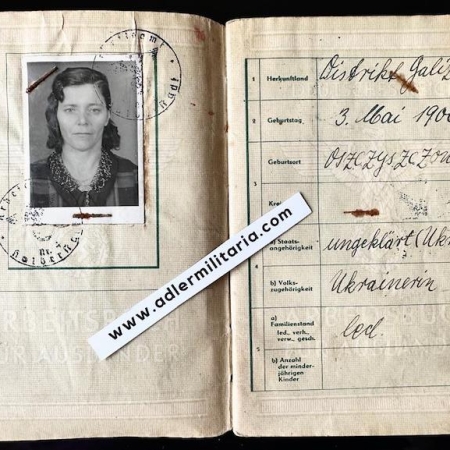
Arbeitsbuch Für Ausländer – Ukrainian Eva Melnyk – From District Galizien
$125.00An interesting Work book with period applied photograph, Melnyk was from Galizien district in Ukraine and arrived in 1942 for work a farm in Germany (Badersleben) where she worked till the wars end.
-
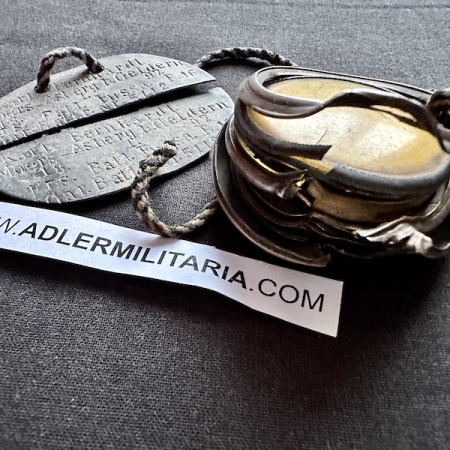
WW1 German Solders ID Tag and “Battle-damaged” Pocket Watch – Karl Bernhardt – Ers.Batl Fuss. Gar. Batt Nr 5112 –
$695.00Incredible little group. The battle damage likely deflected shrapnel or a bullet. The German Dog Tag is marked with: Karl Bernhardt Born: 12.1.1897 Unit: Ersatz Batl Fuss Gar Batt Nr 5112 Research shows that Karl Bernhardt survived the war and died in his hometown of Moers in 1966 of ill health. Watch: Incased old watch, was hit and opened, his name and date of birth matching the tag are engraved inside the watch. When we took this apart to show you the internal system of the watch it began to move. We have a video of it and will be given to the next owner…
-

WW1 German Soldbuch and Militärpass – Uffz Illies – Landwehr Infanterie Regiment 37 – Eastern and Western Front – 1914 – 1918
$95.00Uffz Rudolf Illies Born in Blankenburg in 1885. Entered Active Service on the 30th of November 1914 Awarded: Iron Cross Second Class and Brunswick War Merit Cross 2nd Class An impressive battle calendar spanning across both fronts. Served with The 3rd Landwehr Division (3. Landwehr-Division) was an infantry division of the Imperial German Army during World War I. It was formed on the mobilization of the German Army in August 1914 under the “Higher Landwehr Commander 3” (Höherer Landwehr-Kommandeur 3). The Landwehr was the third category of the German Army, after the regular Army and the reserves. Thus Landwehr divisions were made up of older soldiers who had passed from the reserves, and were intended primarily for occupation and security duties rather than heavy combat. While the division was a Landwehr formation, at the beginning of the war it also had an attached Ersatz infantry brigade, made up of cadres from various regimental replacement battalions (this brigade was dissolved in September 1914). The division was primarily raised in the Prussian provinces of Posen, Lower Silesia, and West Prussia. The division was disbanded in 1919 during the demobilization of the German Army after World War I. Combat chronicle The 3rd Landwehr Division fought on the Eastern Front in World War I. It was on the front in Poland from the early days, and participated in the Gorlice-Tarnów Offensive, crossing the Vistula in July and advancing toward the Bug, and eventually reaching the line between the Servech and Shchara rivers, where the front stabilized. It remained in the line there until the armistice on the Eastern Front in December 1917. Thereafter, the division served in the Ukraine and in the German occupation forces in Russia until late September 1918, when it went to the Western Front, serving in the Flanders area until the end of the war. Allied intelligence rated the division as fourth class and of mediocre combat value. Comments: A nice set to a combat soldier,
